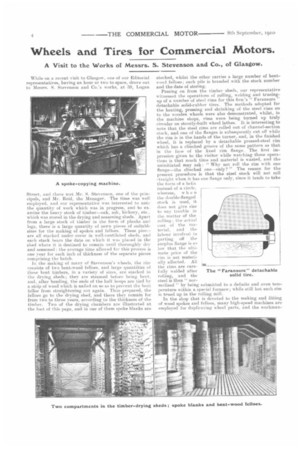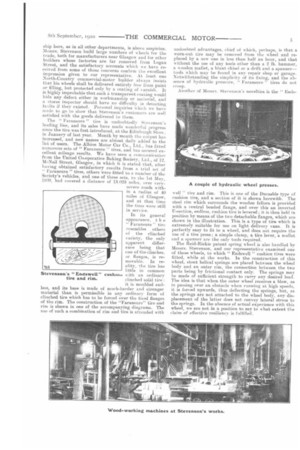Wheels and Tires for Commercial Motors.
Page 4

Page 5

If you've noticed an error in this article please click here to report it so we can fix it.
A Visit to the Works of Messrs. S. Stevenson and Co., of Glasgow.
While on a recent visit to Glasgow, one of our Editorie I representatives, having an hour or two to spare, drove out to Messrs. S. Stevenson and Co.'s works, at 59, lsogan Street, and there met Mr. S. Stevenson, one of the principals, and Mr. Reid, the Manager. The time was well employed, and our representative was interested to note the quantity of work which was in progress, and to examine the heavy stock of timber—oak, ash, hickory, etc.. which was stored in the drying and seasoning sheds. Apart from a large stock of timber in the form of planks and logs, there is a large quantity of sawn pieces of suitably sizes for the making of spokes and felloes. These pies are all stacked under cover in well-ventilated sheds, and each stack bears the date on which it was placed in the shed where it is destined to remain until thoroughly dry and seasoned: the average time allowed for this process is one year for each inch of thickness of the separate pieces comprising the batch.
In the making of many of Stevenson's wheels, the rim consists of two bent-wood felloes, and large quantities of these bent timbers, in a variety of sizes, are stacked in the drying sheds; they are steamed before being bent, and, after bending, the ends of the half hoops are tied by a strip of wood which is nailed on so as to prevent the bent felloe from straightening out again. Thus prepared, the felloes go to the drying slips], and there they remain for from two to three years, according to the thickness of the timber. Two of the drying chambers are illustrated at the foot of this page, and in one of them spoke blanks are stocked, whilst the other carries a large number of bentwood felloes ; each pile is branded with the stock number and the date of storing.
Passing on from the timber sheds, our representative. witnessed the operations of rolling, welding and trueingup of a number of steel rims for this firm's " Faransure " detachable solid-rubber tires. The methods adopted for the heating, pressing and shiinking of the steel rims on to the wooden wheels were also demonstrated, whilst, in the machine shops, rims were being turned up truly circular on stoutly-built wheel lathes. it is interesting to note that the steel rims are rolled out of channel-section stock, and one of the flanges is subsequently cut off while the rim is in the hands of the turner, and, in the finished wheel, it is replaced by a detachable pressed-steel rim which has a clinched groove of the same pattern as that. in the face of the fixed • rim flange. The first impression given to the visitor while watching these operations is that much time and material is wasted, and the uninitiated may ask: " Why not roll the rim with one flange—the clinched one—only ? " The reason for the, present procedure is that the steel stock will not roll straight when is has one flange only, since it tends to take the form of a helix instead of a circle, whereas, Iv h e the double-flanged stock is used, it does nut give rise to any trouble in the matter of the rolling: the actual cost of the material, and the labour involved in parting off the surplus flange is se
low that the ultiAss mate price of the rim is not materially affected. All the rims are care
fully welded after The "Faransure" detachable rolling, and the solid tire.
steel is then " nor malized " by being submitted to a definite and even temperature within a special furnace; while still hot each rim is trued up in the rolling mill, In the shop that is devoted to the making and fitting of wood spokes and felloes, many high-speed machines are employed for duplicating wheel parts, and the workman
ink
ship here as in all other departments, is above suspicion. Messrs. here, build large numbers of wheels for the trade, both for manufacturers near Glasgow and for other builders whose factories are far removed from Logan Street, and the satisfactory accounts which we have received from some of those concerns confirm the excellent impression given to our representative. At, least one North-Country commercial-motor builder always insists that his wheels shall be delivered entirely free from paint or filling, but protected only by a coating of varnish. It is highly improbable that such a transparent coating would hide any defect either in workmanship or material, and a stores inspector should have no difficulty in detecting faults if they existed. Personal inquiries 1%hicii we have made to go to show that. Stevenson's customers are well satisfied with the goods delivered to them.
The " Faransure " tire is undoubtedly Stevenson's leading line, and its sales have made wonderful progress since the tire was first introduced, at the Edinburgh Show, in January of last year. Month by month the output bus increased, and new names are almost daily added to the list of users. The Albion Motor Car Co., Ltd., has fitted numerous sets of " Faransure " tires, and has secured excellent mileage results. We have seen a communication from the United Co-operative Baking Society, Ltd., of 12, McNeil Street, Glasgow, in which it is stated that, after having obtained satisfactory results from a trial set of " Faransure " tires, others were fitted to a number of the Society's vehicles, and one of these sets, to the 1st May, 1909. had covered a distance of 1:3.023 miles, over verysevere roads within a radius of 40 miles of Glasgow, and at that time the tires were still ill service.
In it general oppearance, t h e " Faransure" tire resembles others of the clinched variety, the only apparent difference being that one of the clinches, or flanges, is removable. In reality, the tire has little in common with an ordinary clinched solid tire : it is moulded endless, and its base is made of nitwit-harder and stronger material than is permissible in any ordinary form of clinched tire which has to be forced over the fixed flanges of the rim. The construction of the "Faransure" tire and rim is shown in one of the accompanying diagrams. The use of such a combination of rim and tire is attended with
Stevenson's " Endswell" cushioa tire and rim.
undoubted advantages, chief of which, perhaps, is that a worn-out tire may be removed from the wheel and replaced by a new one in less than half an hour, and that without the use of any tools other than a 2 lb. hammer, a wooden mallet, a blunt chisel or a drift and a spanner— tools which may be found in any repair shop or garage. Notwithstanding the simplicity of its fixing, and the absence of hydraulic pressure, " Faransure " tires do not creep. Another of Messrs. Stevenson's novelties is the " Ends well " tire and rim. This is one of the Dueasble type of cushion tire, and a section of it is shown herewith. The steel rim which surrounds the wooden felloes is provided with a central beaded flange, and over this an inverted U-section, endless, cushion tire is levered ; it is then held in position by means of the two detachable flanges, which are shown in tho illustration. This is a type of tire which is extremely suitable for use on light delivery vans. It is perfectly easy to fit to a wheel, and does not require the use of a tire press ; a simple clamp, a tire lever, a mallet and a spanner are the only tools required.
The Reid-Riekie patent spring wheel is also handled by Messrs. Stevenson, and our representative examined one of these wheels, to which " Endswell " cushion tires were fitted, while at the works. In the construction of this wheel, stout helical springs are placed between the wheel body and an outer rim, the connection between the two parts being by frictional contact only. The springs may be made of sufficient strength to carry any desired load. The idea is that when the outer wheel receives a blow, as in passing over an obstacle when running at high speeds, it is forced upwards, thus deflecting the springs, but, as the springs are not attached to the wheel body, any displacement of the latter does not convey lateral stress to the springs. In the absence of actual experience with this wheel, we are not in a position to say to what extent the claim of effective resiliency is fulfilled.
























